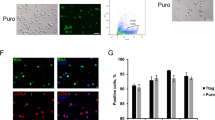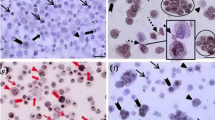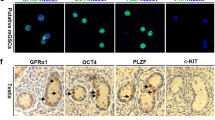Abstract
Purpose
To study the effects of serum and growth factors on propagation of porcine male germline stem cells (MGSCs) in vitro and develop a culture system for these stem cells.
Methods
Fresh testicular cells from neonatal piglets were obtained by mechanical dissociation and collagenase-trypsin digestion. After differential plating, non-adhering cells were cultured in media supplemented with different concentrations of serum (0, 1 %, 2 %, 5 %, 10 %). After 10 days of primary culture, the cells were maintained in media supplemented with different concentrations of growth factors (basic fibroblast growth factor and epidermal growth factor at 1, 5, 10 ng/ml). The number of MGSC-derived colonies with different sizes was determined in each treatment to assess the effects of serum concentrations and growth factors.
Results
The number of MGSC-derived colonies was significantly higher in the presence of 1 % rather than 10 % fetal bovine serum (FBS). Basic fibroblast growth factor (bFGF) at 1, 5 ng/ml and epidermal growth factor (EGF) at 5, 10 ng/ml significantly promoted colony formation. Immunocytochemistry, reverse transcriptase-polymerase chain reaction (RT-PCR) and xenotransplantation assays demonstrated the presence of functional stem cells in cultured cell population.
Conclusions
In vitro propagation of porcine MGSCs could be maintained in the presence of 1 % FBS and supplementation of growth factors for 1 month.






Similar content being viewed by others
References
Abu Elhija M, Lunenfeld E, Schlatt S, Huleihel M. Differentiation of murine male germ cells to spermatozoa in a soft agar culture system. Asian J Androl. 2012;14:285–93.
Aponte PM, Soda T, Teerds KJ, Mizrak SC, van de Kant HJ, de Rooij DG. Propagation of bovine spermatogonial stem cells in vitro. Reproduction. 2008;136:543–57.
Bahadorani M, Hosseini SM, Abedi P, Hajian M, Hosseini SE, Vahdati A, et al. Short-term in-vitro culture of goat enriched spermatogonial stem cells using different serum concentrations. J Assist Reprod Genet. 2012;29:39–46.
Barnes D, Sato G. Serum-free cell culture: a unifying approach. Cell. 1980;22:649–55.
Dores C, Alpaugh W, Dobrinski I. From in vitro culture to in vivo models to study testis development and spermatogenesis. Cell Tissue Res. 2012;349:691–702.
Goel S, Fujihara M, Minami N, Yamada M, Imai H. Expression of NANOG, but not POU5F1, points to the stem cell potential of primitive germ cells in neonatal pig testis. Reproduction. 2008;135:785–95.
Goel S, Fujihara M, Tsuchiya K, Takagi Y, Minami N, Yamada M, et al. Multipotential ability of primitive germ cells from neonatal pig testis cultured in vitro. Reprod Fertil Dev. 2009;21:696–708.
Goel S, Sugimoto M, Minami N, Yamada M, Kume S, Imai H. Identification, isolation, and in vitro culture of porcine gonocytes. Biol Reprod. 2007;77:127–37.
Hamra FK, Chapman KM, Nguyen DM, Williams-Stephens AA, Hammer RE, Garbers DL. Self renewal, expansion, and transfection of rat spermatogonial stem cells in culture. Proc Natl Acad Sci U S A. 2005;102:17430–5.
Honaramooz A, Megee SO, Dobrinski I. Germ cell transplantation in pigs. Biol Reprod. 2002;66:21–8.
Hwang K, Lamb DJ. New advances on the expansion and storage of human spermatogonial stem cells. Curr Opin Urol. 2010;20:510–4.
Jiang FX. Male germ cell transplantation: promise and problems. Reprod Fertil Dev. 2001;13:609–14.
Jiang FX, Short RV. Male germ cell transplantation: present achievements and future prospects. Int J Dev Biol. 1998;42:1067–73.
Kanatsu-Shinohara M, Inoue K, Ogonuki N, Morimoto H, Ogura A, Shinohara T. Serum- and feeder-free culture of mouse germline stem cells. Biol Reprod. 2011;84:97–105.
Kanatsu-Shinohara M, Miki H, Inoue K, Ogonuki N, Toyokuni S, Ogura A, et al. Long-term culture of mouse male germline stem cells under serum-or feeder-free conditions. Biol Reprod. 2005;72:985–91.
Kanatsu-Shinohara M, Muneto T, Lee J, Takenaka M, Chuma S, Nakatsuji N, et al. Long-term culture of male germline stem cells from hamster testes. Biol Reprod. 2008;78:611–7.
Kanatsu-Shinohara M, Ogonuki N, Inoue K, Miki H, Ogura A, Toyokuni S, et al. Long-term proliferation in culture and germline transmission of mouse male germline stem cells. Biol Reprod. 2003;69:612–6.
Kim BG, Cho CM, Lee YA, Kim BJ, Kim KJ, Kim YH, et al. Enrichment of testicular gonocytes and genetic modification using lentiviral transduction in pigs. Biol Reprod. 2010;82:1162–9.
Kubota H, Avarbock MR, Brinster RL. Growth factors essential for self-renewal and expansion of mouse spermatogonial stem cells. Proc Natl Acad Sci U S A. 2004;101:16489–94.
Kuijk EW, Colenbrander B, Roelen BA. The effects of growth factors on in vitro-cultured porcine testicular cells. Reproduction. 2009;138:721–31.
Lim JJ, Sung SY, Kim HJ, Song SH, Hong JY, Yoon TK, et al. Long-term proliferation and characterization of human spermatogonial stem cells obtained from obstructive and non-obstructive azoospermia under exogenous feeder-free culture conditions. Cell Prolif. 2010;43:405–17.
Luo J, Megee S, Dobrinski I. Asymmetric distribution of UCH-L1 in spermatogonia is associated with maintenance and differentiation of spermatogonial stem cells. J Cell Physiol. 2009;220:460–8.
Luo J, Megee S, Rathi R, Dobrinski I. Protein gene product 9.5 is a spermatogonia-specific marker in the pig testis: application to enrichment and culture of porcine spermatogonia. Mol Reprod Dev. 2006;73:1531–40.
Nagano MC. Techniques for culturing spermatogonial stem cells continue to improve. Biol Reprod. 2011;84:5–6.
Ryu BY, Kubota H, Avarbock MR, Brinster RL. Conservation of spermatogonial stem cell self-renewal signaling between mouse and rat. Proc Natl Acad Sci U S A. 2005;102:14302–7.
Sadri-Ardekani H, Akhondi MA, van der Veen F, Repping S, van Pelt AM. In vitro propagation of human prepubertal spermatogonial stem cells. JAMA. 2011;305:2416–8.
Sadri-Ardekani H, Mizrak SC, van Daalen SK, Korver CM, Roepers-Gajadien HL, Koruji M, et al. Propagation of human spermatogonial stem cells in vitro. JAMA. 2009;302:2127–34.
Seandel M, James D, Shmelkov SV, Falciatori I, Kim J, Chavala S, et al. Generation of functional multipotent adult stem cells from GPR125+ germline progenitors. Nature. 2007;449:346–50.
Takahashi K, Yamanaka S. Induction of pluripotent stem cells from mouse embryonic and adult fibroblast cultures by defined factors. Cell. 2006;126:663–76.
Tegelenbosch RA, de Rooij DG. A quantitative study of spermatogonial multiplication and stem cell renewal in the C3H/101 F1 hybrid mouse. Mutat Res. 1993;290:193–200.
Walters EM, Wolf E, Whyte JJ, Mao J, Renner S, Nagashima H, et al. Completion of the swine genome will simplify the production of swine as a large animal biomedical model. BMC Med Genomics. 2012;5:55.
Wu Z, Falciatori I, Molyneux LA, Richardson TE, Chapman KM, Hamra FK. Spermatogonial culture medium: an effective and efficient nutrient mixture for culturing rat spermatogonial stem cells. Biol Reprod. 2009;81:77–86.
Acknowledgments
We thank Yangling Guangming pig farm for providing porcine testis tissues. This work was supported by the National Natural Science Foundation of China (Grant No. 31072029, No. 31272439), and the Scientific Research Foundation for the Returned Overseas Chinese Scholars from Northwest A&F University.
Declaration of interest
The authors declare that there is no conflict of interest that could be perceived as prejudicing the impartiality of the research reported.
Author information
Authors and Affiliations
Corresponding author
Additional information
Capsule
This study showed the optimum concentrations of serum and growth factors for propagation of porcine male germline stem cells (MGSCs) in vitro and finally established a culture system for these stem cells.
Rights and permissions
About this article
Cite this article
Zheng, Y., Tian, X., Zhang, Y. et al. In vitro propagation of male germline stem cells from piglets. J Assist Reprod Genet 30, 945–952 (2013). https://doi.org/10.1007/s10815-013-0031-0
Received:
Accepted:
Published:
Issue Date:
DOI: https://doi.org/10.1007/s10815-013-0031-0




